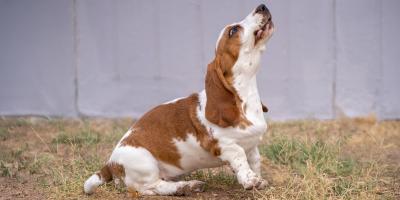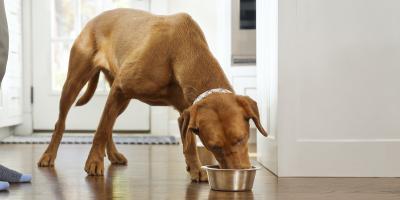Dog Training: How to Potty Train an Adult Dog


Potty training is commonly associated with puppies, but many adult dogs need to be taught the rules as well. Whether they were inconsistently trained (or never trained at all), or seem to have forgotten what to do, there are different reasons your canine companion may not understand when and where to go.
So, if you’re wondering how to potty train an adult dog, read on for some useful tips and instructions. Hopefully, they can help you form a consistent (and less messy) routine for your pet.
Dog Potty-Training Regression: What is It?
You may need to know how to house-train an adult dog because they’ve regressed in their training.
Potty training regression occurs when a dog starts having accidents in places they know are off limits, like your home, despite being trained to do their business outside.
Reasons for potty-training regression in adult dogs can be related to stress. These include:
- Change in environment (e.g., your dog was re-homed or recently adopted)
- The addition of a new family member or pet to your household
- Change in routine (e.g., people in the home go back to work or school)
- Loss of a person or pet in the family
House-training regression in older dogs may also occur due to an underlying medical condition, such as:
- Urinary tract infection
- Kidney stones
- Bladder or kidney disease
- Diabetes
- Cushing’s and Addison’s disease
- Canine Cognitive Dysfunction Syndrome (CDS)
Bottom line: If your adult dog has potty-training regression, contact your veterinarian to rule out illness as a cause. If regression is related to stress, it will likely pass as you help your dog cope with their anxious feelings.
How to House-Train an Adult Dog
House-training a dog who’s older may be easier than you think.
Adult canines can be slower to adapt to new routines than puppies, but they’re also able to focus for longer periods of time. That’s why they can successfully learn obedience training and crate training, despite their reputation for refusing to follow new commands and habits.
Follow these instructions to potty train your older dog:
- Establish a routine. Try to take your dog outside – on a leash – at the same time every day, ideally first thing in the morning and after meals.
- Reward with treats and praise. Use positive reinforcement when they go potty outside.
- Take frequent bathroom breaks. In addition to your routine trips outside, give your dog ample opportunities to relieve themselves.
- Keep your dog leashed by your side, or in sight. While inside, make sure your pet can’t wander off in the home.
- Set up a restricted area for your dog when they’re unsupervised. Using a barrier, such as a baby gate, create an area that’s big enough to turn around in but limits access to the rest of your home. (If your pet already uses a crate, place it in the area.) The intent is to eliminate accidents in the house, as dogs generally don’t like to potty in their living space.
- Gradually expand the restricted area. Once your dog can go several days without an accident, give them more space. If they regress, decrease the area again.
- Watch for warning signs. Pacing, whining or barking may be signs that they need to be let out.
- Don’t punish them over mistakes. It’s not unusual for adult dogs who aren’t potty trained to have an accident at some point. Avoid punishing them for it. This can make them fearful of you or going potty in your presence, rather than teaching a lesson.
How Long Does it Take to Potty Train a Dog?
Most adult dogs can be potty trained within a few weeks. If you have a small or senior dog, the timeline may be a little longer, as they sometimes have less control over when they pee and poop.
Can You Train an Older Dog to Use Pee Pads?
Yes, you can train an older dog to use pee pads. These may be a good option if you, say, have a small dog and live in a building without easy outdoor access, or have a dog with mobility issues. Training your canine to use pads is a similar process to taking them outside when they need to go.
Signs Your Dog Needs to Go Out
An important part of housebreaking a dog is knowing when they need to go outside. Here are some signs to watch for:
- Walking to the door
- Circling or pacing
- Crying or barking
- Sniffing the ground
- Pawing the door
- Searching for a hidden area in the home
How Often Should I Take My Dog Out?
Part of how to train a dog to pee outside is understanding how often dogs need potty breaks.
Take them out approximately once an hour at first. This can be in addition to letting them out after meals, in the morning and at night (and any other times you deem necessary).
After some time, if you think they’re ready, gradually extend the time between potty breaks (e.g., 90 minutes to 2 hours).
Eventually, the goal is for them to follow a daily routine of limited potty breaks.
How Long Can Dogs Hold Their Pee?
If you’re wondering, How long can a dog go without peeing?, adult dogs can generally control their bladder for up to ten hours. This is an approximation, as some dogs need to go out sooner and others can hold it a bit longer.
Try not to put your pet in an uncomfortable situation, though. And remember, extra-long periods of time between potty breaks increase the chances of an accident.
How to Stop a Dog From Peeing in the House
The best way to stop a dog from urinating in the house is by regularly taking them outside. Praising and rewarding them when they go potty in the right place also reinforces their training.
If you catch your dog eliminating in your home, startle – but don’t scare – them. Quickly take them outside to their potty place and reward them if they finish.
Also, make sure to thoroughly clean up any messes. Your dog has an excellent sense of smell. If they detect scents of urine or feces in an area, they may want to soil that spot again.
Other Reasons Your Dog May Be Peeing in the House
In addition to a lack of training, stress and medical conditions, here are some possible reasons your adult dog may be going potty in your home:
- Marking their territory (especially in a home with other pets or new people)
- Overexcitement or fear
- Separation anxiety
Older canines may resist new routines at first, but it doesn’t mean they can’t learn them. So, if you’re wondering how to potty train a stubborn older dog, remember to be patient. They’re not just learning a new habit; they’re unlearning an old one.
Find additional dog training insights on the myPurina app, featuring our “How to Potty Train a Puppy” video.
For your own personalized dog training plan, download Zigzag, the most advanced dog training app, for free and unlock 1 month of Premium Access with unlimited lessons, tailored guidance, and 24/7 expert support using code PUR30 at payment.
Install Zigzag for free now to get started
Related articles

Reward Yourself with myPurina
Earn and redeem rewards for Purina products with the myPurina app.






